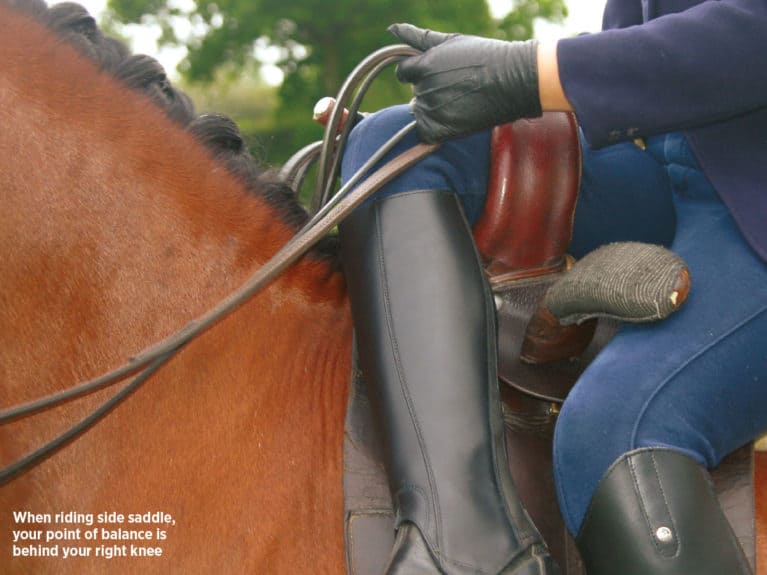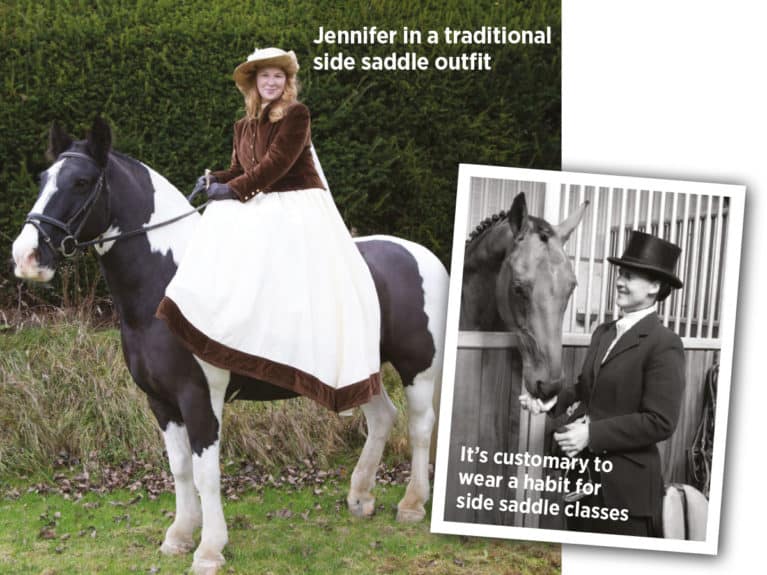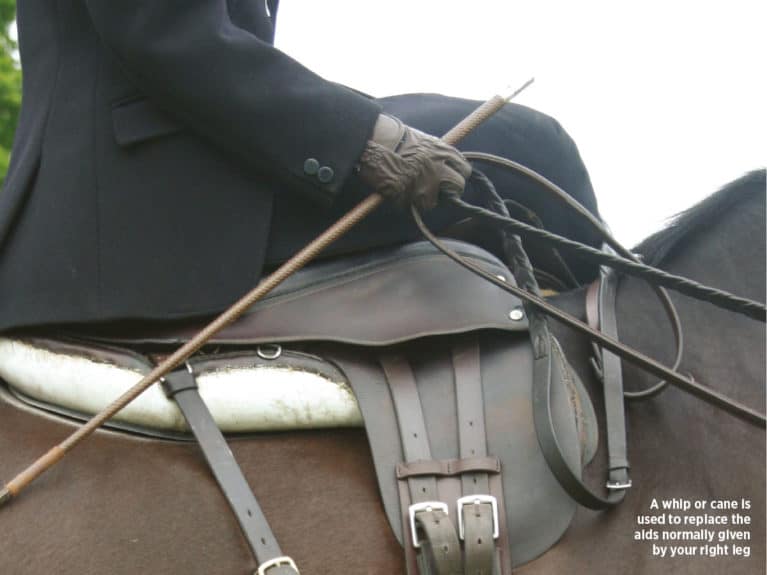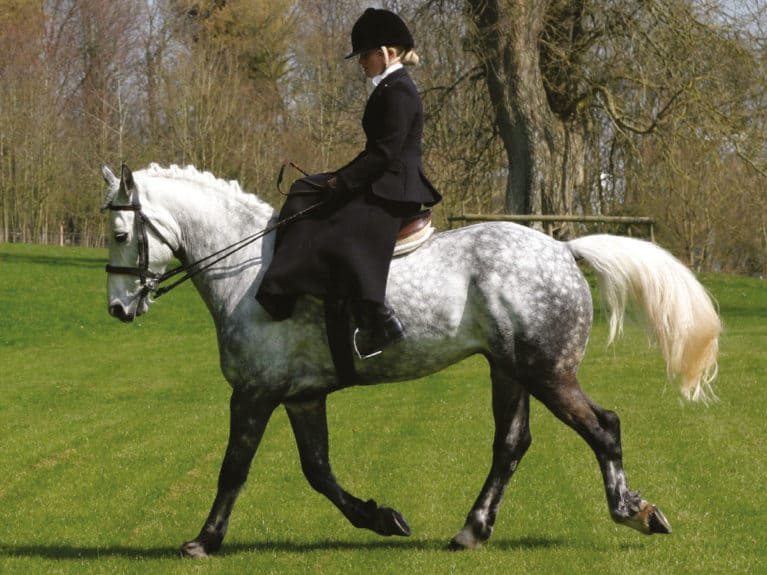How Easy is It to Ride Side Saddle
Elegant and skilled, but too really hard and a bit scary? Side saddle is as alluring as information technology is intimidating, but it'southward great fun, as Jennifer Blockley found out
Have y'all ever wondered what it would be like to ride side saddle? Is it scary? Is it easy to remainder, and is information technology as comfy and enjoyable every bit riding astride?
Whenever I run into someone riding side saddle, I'm impressed at how elegant they wait. I love the whole picture, the genteel expect of the costume and how the brim drapes across the equus caballus, so I set out to find out more. My first port of call was side saddle guru, Roger Philpot. His passion for the sport means that he has become something of a side saddle celebrity, and he fifty-fifty trained side-saddle stunt adult female Pippa Booth, who doubled for Downton Abbey'south Lady Mary.
My first question for Roger is but how hard it will be to accommodate to riding side saddle. He explains: "If yous're an experienced rider, y'all tin can pick it up relatively quickly on a trained side saddle horse." Roger also allays my rubber concerns, proverb: "Side saddles apply safety stirrups, and y'all tin concord onto the pommel if you want to. The large divergence is that your point of residuum is behind your correct human knee, which is apparently very different to astride riding."
I acknowledge that the beautiful dresses worn by side saddle riders are function of the sport's appeal, but Roger tells me that it'due south fine to wear your normal astride clothes to learn in, and there are even some classes where it's not mandatory to wear a habit."

A niggling bit of history
Side saddle was the traditional way for a lady to ride – it was impractical to ride astride considering ladies wore long skirts. Male person grooms even rode side saddle to keep the horses fit for their lady owners. It wasn't until during the Second World War that the tendency for ladies to ride astride developed.
In 1974, Valerie Francis and Janet Macdonald formed The Side Saddle Association to preserve this elegant tradition. In fact, side saddle is not strictly for women and Roger explains that some men are trying it, too. Furthermore, a lot of riders with medical conditions, such as those with back problems and riders who take lost the use of their legs still have the option to ride side saddle, which means that they can continue to ride.
What to wear
In almost side saddle classes, it's customary to wearable a habit, which comprises of a jacket and skirt. The brim is referred to as an apron and is really a safety skirt, which prevents yous being dragged should you fall.
Side saddles take 2 pommels. The top 1 is called a stock-still head and your right leg wraps around it. The lower pommel is called a leaping head and is moulded in the opposite direction. Roger stresses the importance of a correctly fitting saddle. "The saddle must back up the equus caballus and passenger, especially under the left seat bone. If it's correctly fitted and in remainder, information technology allows the rider to concentrate on riding instead of fighting the saddle."
Because both legs are on the left side of the horse, and your 'elevation' leg (the correct) is only used for balancing purposes, a schooling whip or extended cane with a curved end is usually held in the correct hand and used on the flank to replace the aids that are normally given by the right leg when riding astride. The aids remain exactly the same as astride riding.

The position
Getting the correct position is vital. Your point of remainder is now behind your right knee. Roger explains that I demand to use my right leg to grip around the pommel and provide support and balance. My correct thigh does most of the work, and my right pes points downwards, which feels unnatural to begin with. My weight is equally distributed through my buttocks, the aforementioned equally riding astride. The ball of my left pes rests on the stirrup, but with no weight in my heel. Roger guides me through establishing the correct position…
- mountain your horse equally you would normally, using a mounting block. Sit astride and and so place your right leg over the front of the saddle. Your right leg should grip around the pommel with your toe pointing downwards
- place equal weight in your buttocks with your waist facing forward and your upper torso turned slightly clockwise at 5 past twelve
- identify the ball of your left foot in the stirrup but with no weight in the heel
- identify the loop of your reins over the withers on the off side
- carry your schooling whip in your correct hand
With that information technology was time to begin my starting time-ever side saddle lesson. Walking was, it turned out, relatively easy, although keeping my right toe pointing downwards felt a bit odd. The warm-upwardly was much the aforementioned equally I'thou used to when riding astride – plenty of transitions and changes of rein. Walking on the right rein felt natural because my body was angled in that direction anyway. Unlike astride, where you face your body in the direction you want your horse to plough, I was facing the opposite fashion when information technology came to the left rein, which fabricated it a scrap more tricky.
When it came to trotting, I was pleasantly surprised. With my right leg firmly nestled around the fixed head of the saddle, information technology felt quite comfortable. Roger guided me to establishing a balanced working trot and, thankfully, my mount, Geoffrey, wasn't too forward-going or reluctant. All the trot work is done sitting – although Roger tells me that Victorian ladies were adept at rise trot.
After a session establishing walk and trot, as well as transitions, I was exhausted – canter would wait for some other day.

Lasting improvement
The next day, when I ride my own horse, I'm amazed at how much more secure and confident I experience. Roger explained that learning another style of riding helps with your co-ordination, and that side saddle helps you to be straighter and encourages you to become aware of your position.
And so, I did it. My first side saddle lesson was a success. Was it piece of cake? Well, it wasn't as hard every bit I thought it might be, all the same, there is and so much more than to learn. Was it comfortable? Yep, in the main. Will I be back for a second lesson? Effort and finish me!
Have a go
Expect to pay £30–xl for 30 minutes' specialist side saddle instruction. Look for an teacher with a licenced horse – this means the horse is trained in side saddle and examined by the side saddle Clan (SSA) for its suitability.
For a list of local instructors and details of 'have a go' days where you can try side saddle with your own horse, visit sidesaddleassociation.co.britain
mullenuncloyesseen.blogspot.com
Source: https://www.horseandrideruk.com/expert-advice/articles/go-side-saddle/

0 Response to "How Easy is It to Ride Side Saddle"
Post a Comment